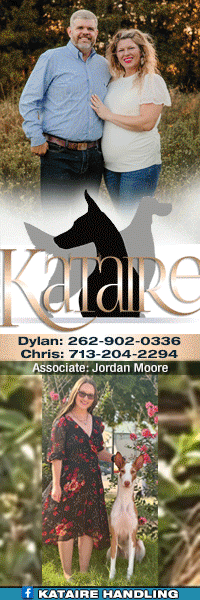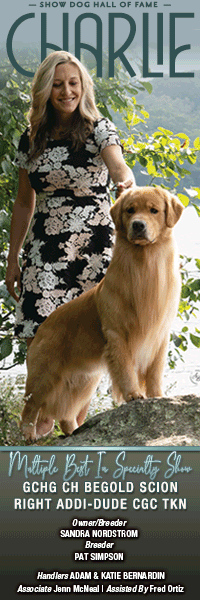Westminster Scandal

GCh. Polar Mist Cruz'n T'party At Zamosky
By Amy Fernandez
Westminster 2013 was still a hot topic on February 28th when national news reported the suspected poisoning of GCh. Polar Mist Cruz’n T’party At Zamosky. Known as Cruz, the three year-old Samoyed died suddenly on February 16. His co owner Lynette Blue and handler Robert Chaffin went on record saying they believed that he was intentionally poisoned while benched at Westminster on February 13.
Cruz arrived from Georgia on Monday the 12th, showed at Westminster on Tuesday, and left with Chaffin for the Rocky Mountain Classic in Lakewood, Colorado on Wednesday. Chaffin called Blue from the show to report that Cruz was ill, coughing blood, and was being rushed to a nearby animal hospital. He was treated by veterinarian Molly Comiskey and died hours later. Testing conducted before his death suggested poisoning as a possible, unconfirmed cause. Media sources, including CNN and The New York Times, quoted Blue and Chaffin voicing their suspicions that animal rights extremists had poisoned Cruz at Westminster.
These comments definitely grabbed the media spotlight. Tales of show dogs coming to harm at the hands of jealous competitors and spiteful enemies has morphed into an urban legend. Although it’s actually pretty rare, it ranks right up there with UFO sightings- and that perception is not confined to people outside the dog fancy.
Westminster dismissed the poisoning allegation, emphasizing that no other dogs fell ill at the show, and going on to say that they have no knowledge of any such incident in Westminster’s history. However, like all great urban legends, this one has some basis in fact. It entered Westminster lore in 1895 with a case that made headlines around the world. On February 23 The Times reported “Eight of Mrs. Senn’s Pets Killed by a Miscreant at the Dog Show. Jealousy believed the Motive.”

Prominent Toy exhibitors William and Flora Senn lived at 278 W 11th, close by MSG’s original location. They did big winning, especially in Yorkshire Terriers, which included finishing the breed’s first Ambred champion, Queen of the Fairies. On February 21 they left eight Yorkies, Chins, and ETs benched at the Garden overnight. They returned the next morning to find six of them dead and the others gravely ill. The show vet, Dr. Glover, initiated treatment but both dogs succumbed within 15 minutes. The news spread through the show like wildfire. Dr. Foote, an M.D. also exhibiting that day, took a look. “Drs. Glover and Foote made a hasty examination of the dogs and declared that they had been poisoned with strychnine.” Subsequently, Bennett Beach M.D. conducted a necropsy on one of them. His results were reprinted in The Times report. “Chemical analysis shows the presence of strychnine in considerable quantity; was able to isolate crystals of the alkaloid from the solution of contents of the stomach.” Police investigations, private detectives, and substantial rewards yielded no perp or motive.
News reports also alluded to another notorious strychnine poisoning of a champion Bull Terrier owned by James Hinks at the 1858 Manchester show. In that case, the culprit was apprehended and convicted. Although it happened in England 30 years earlier, it was likely at the forefront of dog talk in 1896 because a dog poisoner was on the loose in the New York area. This October 11 incident in Port Jefferson was typical. The Times reported that ten valuable purebred Beagles, Poodles, and Setters were poisoned the previous night after ingesting “Small pieces of fresh beef rolled into lumps filled with arsenic and tied with fine twine. A number of dogs have been found dead in the last few weeks, but last night the dog poisoner did wholesale business.”
Random, malicious dog poisonings are more than a myth. In February 1918 The Dog Fancier reported “Twelve valuable dogs have been killed at Herringdale, Toronto as the result of eating Paris green and broken glass sewed up in bacon. After investigations by Inspector Ballingall and Dr. Campbell, veterinary surgeon of the Humane Society Mrs. T. Crozler was arrested at Afton and her husband at Port Credit. The poison was traced to the Crozler home and there was found the rest of the ingredients used.”

Florence Ilch’s Bellhaven Collies
However, documented cases are far outnumbered by unconfirmed allegations. Far and away, the most notorious unsubstantiated incident surrounds the 1929 Westminster BIS winner. The Rough Collie, Laund Loyalty of Bellhaven, remains the only Collie and youngest dog to achieve this honor.
Florence Ilch’s Bellhaven Collies were at the top of the game in 1929 when she scored the ultimate Westminster fantasy. Nine month old “Don” arrived as part of a package deal from Ashtead Collies in England days before Westminster. Don had never been shown, and wasn’t registered when Ilch tossed in an entry for him along with 17 other Bellhaven Collies that year. He topped a Breed entry of 120, took the Group, and landed in a BIS lineup facing off against challengers like the Wildoaks Wire Eden Aristocrat and the top winning Pointer, Ch. Herewithem J.P. Needless to say, this particular Westminster upset win upset plenty of Ilch’s fellow competitors.
Don never finished because he was never shown again. Ilch initially claimed that she had received anonymous threats warning her that he would be maimed or killed. Her paranoia was justified. In 1928, shortly before Collie judging at Westminster she received a telegram saying that her son had suffered a fatal accident. She fainted on the spot. It turned out to be fake. The sender was never caught. Later in 1929, Ilch reported that Don had been blinded after Westminster when acid was thrown in his eyes. No vet reports were released to corroborate the story, but like most scandalous rumors, it had legs. It appeared in The Times as recently as 1966.
Many suspicious dog show deaths attributed to poisoning follow similar vague, conspiratorial scenarios even though verifiable causes were to blame. This topic deserves its own column so I’ll just mention a couple. Tainted dog food made headlines in 2007, but it was a routine hazard before the advent of food safety regulations. Arsenic, lead, mercury, and other “healthful” ingredients were commonly added to commercial foods, OTC meds, vitamin tonics, and grooming supplies. Before safe, effective vaccines became available innumerable dogs died sudden, horrible deaths from hepatitis and distemper. Shipping dogs to and from shows also resulted in plenty of fatalities from heat, cold, and mishandling.
The death of Cruz will add weight to these urban legends. Dogs are deliberately poisoned but even today, it is difficult to verify. Almost every possible clinical symptom of poisoning can also be caused by a multitude of unrelated medical problems.
In this case, a warfarin type anti-coagulant rodenticide was suspected. Rodenticide toxicity ranks among the most common causes of poisoning in dogs, but a mind boggling number of substances fall within this category. They typically inhibit blood clotting but signs can range from profusely bleeding wounds, large, unexplainable hematomas, swollen gums, swollen joints, sudden abdominal distension, respiratory distress, coughing or vomiting blood, shock, or sudden multiple organ failure. Many factors account for these varying reaction to rodenticide compounds, which can vary from mild illness to sudden death. Product formulations, additives, and freshness influence digestibility, absorption rates, and overall toxicity. These variations also depend on factors such as the dog’s general health, age, size, body mass, drug tolerance, individual metabolism, and the amount ingested. In general, the more commonly used household rodenticides must be ingested repeatedly to be fatal.

Dogs also ingest less common anticoagulants like Vitamin D analogues and metal phosphide poisons designed for larger pests like rabbits and squirrels. And good old standbys like cyanide are still around. Single feed rodenticides like bromadiolone and difethialone are more lethal. They are metabolized slowly and lethal amounts remain in the tissue after death. Carcasses of dead animals can cause secondary poisoning if dogs chew or consume them.
In this case, no necropsy or further toxicological tests was done to confirm the cause of death. Their grief and reluctance is understandable. No one wants to contemplate a deceased loved one in that context. But as things stand, his tragic death will reinforce negative perceptions about dog shows and fuel rumors rather than resolving a mystery that might have provided useful information for other exhibitors. Dogs are deliberately poisoned, but this doesn’t compare to the risks posed by accidental poisoning. Blue and Chaffin insisted that Cruz had no opportunity to accidentally ingest poison, but you never know what your dog may encounter in unfamiliar environments. This is a truly heartbreaking story, and I wish I had a better takeaway message to end it. Never, never, never leave your dogs unattended at a show.

Short URL: http://caninechronicle.com/?p=17284
Comments are closed











